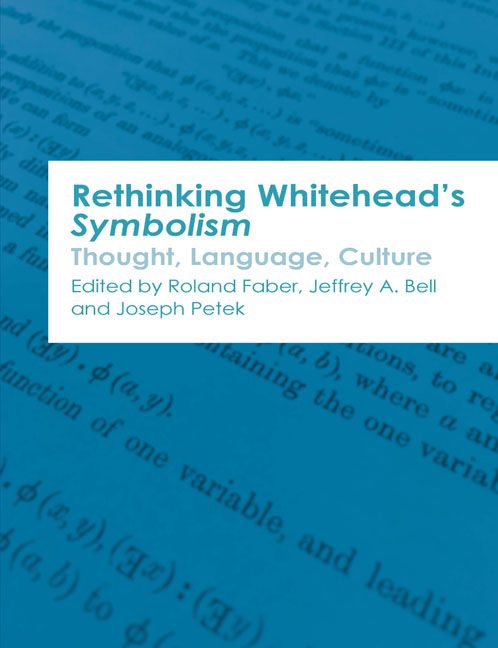Introduction
Published online by Cambridge University Press: 23 June 2018
Summary
Alfred North Whitehead's somewhat obscure book Symbolism: Its Meaning and Effect was originally delivered in April 1927 as the Barbour-Page lectures, at the University of Virginia, about a year before he gave the Gifford lectures, which would become Process and Reality. The latter work often overshadows the former, particularly given that it picks up many of Symbolism's threads while also contextualising them within a larger metaphysical scheme. Yet Symbolism's rather concentrated focus on perception and language is a large part of what recommends the book to our attention, for Whitehead is usually considered a difficult philosopher to grasp, an unsurprising assessment for a thinker whose motto was to ‘seek simplicity and distrust it’ (CN 163). This is not to say that Symbolism is not rich with broader metaphysical and social implications, but only that it is one of his most approachable and accessible works.
Missing Prehensions
Some of the elements that are missing from the book are almost as important as what it contains. For one, it is his only philosophical work which makes no explicit reference to God or religion. For another, Whitehead had not yet decided upon the most suitable terms to express his ideas. It is perhaps not overly surprising that Symbolism contains no reference to ‘eternal objects’ – a concept which Whitehead struggled to communicate clearly, and which he felt was frequently misunderstood by his critics – but even seasoned Whitehead scholars may be surprised to be reminded that the word ‘prehension’ is nowhere in evidence. Given that ‘prehension’ is the one word that is generally seen as anchoring Whitehead's theory of perception, its omission is curious.
He had coined the term two years earlier for his Lowell lectures (which would later be published as Science and the Modern World) in order to communicate an idea of perception that included noncognitive entities, for he was convinced that all actual entities (or ‘events’) just were the creative sum of their perceptions, or ‘prehensive unification/graded envisagement’:
The word perceive is, in our common usage, shot through and through with the notion of cognitive apprehension. So is the word apprehension, even with the adjective cognitive omitted.
- Type
- Chapter
- Information
- Rethinking Whitehead’s SymbolismThought, Language, Culture, pp. 1 - 10Publisher: Edinburgh University PressPrint publication year: 2017

